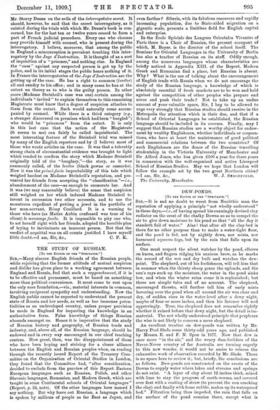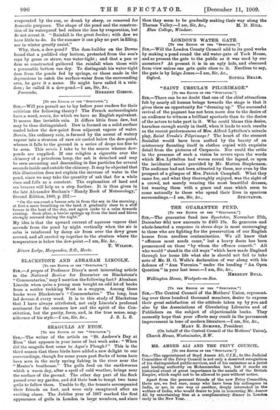DEW-PONDS.
[To THE EDITOR OF' THE " SPICTATOR."1 SIR,—It is sad no doubt to wrest from Neolithic man the reputation of applying a principle "not wholly understood" in these days,—i.e., of having spread his cunningly devised clay radiator on the crest of the chalky Downs so as to compel the air to give down moisture to his pond so that "all the day it standeth full of water." Alas ! that after all the clay-bed is there for no other purpose than to make a water-tight floor, and the pond is fed, not by nightly dews, nor mists, nor harnessed aqueous fogs, but by the rain that falls upon its surface.
One must respect the silent watcher by the pond, elbows on knees, and fingers ridging his anxious brow, as he marks the record of the wet and dry bulb and watches the dew- point. The shepherd, out of his foolishness, will tell him that in summer when the thirsty sheep graze the uplands, and the sun's rays suck up the moisture, the water in the pond sinks low, and when the winter rains come it is replenished ; but these are simple tales and of no account. The shepherd, encouraged thereto, will further tell him of early mists hovering over the pond when all around the air was clear and dry, of sudden rises in the water-level after a dewy night, maybe of four or more inches, and then his listener will nod approvingly. True, the shepherd does not remember rightly whether it rained before that dewy night, but the detail is im- material. The not wholly understood principle that perplexes the wise is not likely to concern a mere shepherd.
An excellent treatise on dew-ponds was written by Mr. Harry Pool Slade some thirty-odd years ago, and published by Messrs. E. and F. N. Spon in 1877. Now that dew is once more "in the air," and the weary dam-builders of the Never-Never country of far Australia are turning eagerly to this new wonder, it would not be amiss to reissue the exhaustive work of observation recorded by Mr. Slade. There is no space here to review it; but, briefly, the conclusions are as follows. Dew-ponds are constructed on the crests of the Downs to supply water where lakes and streams and springs do not exist. "A layer of clay about 12 inches thick, mixed with lime to stay the progress of earth-worms, and covered over that with a coating of straw (to prevent the sun cracking the clay) and finally with loose rubble, makes up its waterproof bed." Filtration being thus impeded, the rain that falls on the surface of the pond remains there, except what is evaporated by the sun, or drunk by sheep, or removed for domestic purposes. The shape of the pond and the construc- tion of its waterproof bed reduce the loss by evaporation, but do not arrest it. "Rainfall is the great feeder; with dew we have little to do. In the summer it can play no part infilling, nor in winter greatly assist."
Why, then, a -dew-pond? The dam-builder on the Downs round that a paddled clay bottom, protected from the sun's rays by grass or straw, was water-tight ; and that a pan or dam so constructed gathered the rainfall when those with a permeable bottom ran dry. To distinguish his water-tight dam from the ponds fed by springs, or those made in the depressions to catch the surface-water from the surrounding area, he gave it a name. He might have called it a. rain- dam ; he called it a dew-pond.---I am, Sir, &c.,

























































 Previous page
Previous page